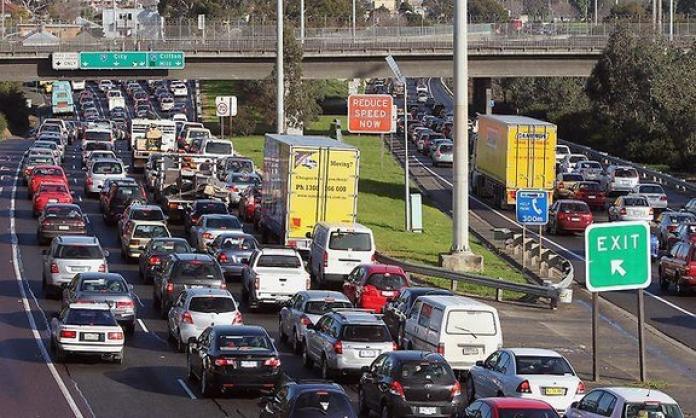Our cities are under enormous pressure. As the population grows, the shortcomings of our infrastructure become more and more apparent.
We sit for extended periods in a car park otherwise known as a freeway, or wait ages for inadequate public transport. Decent affordable accommodation is getting harder and harder to find. Schools and hospitals are overcrowded and under-resourced.
Some people are using people’s legitimate concerns about these issues to argue that immigration is to blame, and should therefore be cut.
Tony Abbott in February called for immigration to be cut from 190,000 to 110,000 people a year. He told the Sydney Institute: “My issue is not immigration; it’s the rate of immigration at a time of stagnant wages, clogged infrastructure, soaring house prices and, [unable to resist a racist dog whistle] in Melbourne at least, ethnic gangs”.
Herald Sun columnist Andrew Bolt and One Nation leader Pauline Hanson waded in to support him. But it’s not just these traditional warriors of the right blaming migration: former NSW Labor premier Bob Carr appeared on the ABC’s Q&A in March and called for immigration to be cut by half to take the pressure off our cities. The enthusiastic applause he received indicates that this idea is gaining ground.
An Essential poll in April told a similar story. Fifty-four percent of those surveyed believe Australia’s rate of population growth is too fast; 64 percent think immigration over the past decade has been too high.
But while it may seem like “common sense” to blame population growth for our increasingly unliveable cities, it’s a fallacy that lets the real culprits off the hook. And the culprits include some of those now baying the loudest for immigration cuts.
For example, Abbott proclaimed himself as the “infrastructure prime minister”. But in the two years to September 2015, federal infrastructure spending declined 17 percent. What’s more, he cancelled all public transport projects not already under construction and re-allocated the funding to new toll roads.
Yet numerous studies, plus the experience of cities much larger than Australia’s, show that well-planned public transport is the most efficient means of moving large numbers of people around. Building more roads just leads to more congestion.
Public transport usage in Australia’s major cities increased by an average of 65 percent over the decade to 2013. It’s a no-brainer that if public transport was better, even more people would use it. Yet governments of all stripes remain captive to the roads lobby and huge corporations like Transurban.
Abbott’s government also cut health and education spending. The Turnbull government has continued on the same trajectory.
Carr’s record is little better. His response to widespread criticism that his government failed to spend enough on infrastructure was to blame public sector wage rises and the opposition of unions, the community and his own party to his plans to sell the state’s electricity industry – which, as we have seen elsewhere, would only increase energy prices.
He also vetoed the building of a rail line to Bondi Beach to ease traffic congestion, bowing to the wishes of the well-heeled residents of the area aghast at the prospect of an “invasion of westies”.
Melbourne is Australia’s fastest growing city, recording its highest ever population increase of 125,000 in the past year. But Melbourne’s infrastructure woes go back a lot further. Much of them can be attributed to the slash and burn policies of the Kennett era in the 1990s and the failure of subsequent Labor governments to reverse the damage.
The Andrews government has some infrastructure projects under way, such as the Metro Tunnel, and is building more schools. But the $6.5 billion allocated to roads dwarfs the $1.9 billion spend on Melbourne’s public transport network.
Neoliberal government policies mean that business logic has invaded social spending. Just about every infrastructure proposal must pass the “business case” of generating more money than it costs. The problem is that most of the infrastructure we need is about the public good, not profitability. That hinders making rational decisions and is a major barrier to building anything of real use.
For example, most of Melbourne’s rail system was built in the late 1800s, when the population was only half a million. It would never have passed today’s “business case” – it was seen as a necessary public service. A train line to Dandenong was built 130 years ago, when hardly anyone lived there. Yet today, the government can’t build a line to Doncaster, a population centre just 15 kilometres from the city and with land for it already set aside along the Eastern Freeway.
Immigrants aren’t responsible for these stupid decisions.
The argument that immigration leads to higher housing prices also doesn’t hold water. In Australia, seven out of 10 new migrants either live with friends or rent. And , despite the record population growth in Melbourne and Sydney, house prices in both cities have recently been declining.
The main problem is that, since the 1990s, a huge expansion of credit, combined with policies favouring investors, has led to greater levels of speculation at the same time as the direct contribution of federal and state governments to public housing has declined.
In the decades after world War Two, by comparison, record rates of home building outstripped rapid population growth, and house prices barely moved. Building an extra 50,000 homes a year for a decade would lower national house prices by between 5 and 20 percent. But instead of investment, we see governments, like Labor in Victoria, selling public housing estates to their developer mates.
So don’t blame immigration for the parlous state of our cities; as always, migrants are merely the scapegoats. Social planning and mass public investment are the basis for dealing with the problems. It’s a question of political priorities.
Rather than giving blank cheques to developers, toll road operators and high income investors, governments should be taxing the rich and spending big on housing and public transport.









